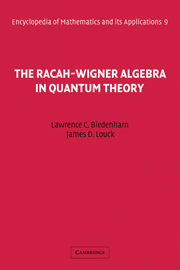Book contents
- Frontmatter
- Contents
- Contents of companion volume
- Editor's Statement
- Section Editor's Foreword
- Preface
- Acknowledgments
- Introduction by George W. Mackey
- The Racah–Wigner Algebra in Quantum Theory
- Chapter 1 Introduction
- Chapter 2 Algebraic Structures Associated with Wigner and Racah Operators
- Chapter 3 Null Space Properties and Structure Theorems for RW-Algebra
- Chapter 4 W-Algebra: An Algebra of Invariant Operators
- Chapter 5 Special Topics
- Appendix of Tables
- List of Symbols
- Author Index
- Subject Index
Introduction by George W. Mackey
Published online by Cambridge University Press: 05 June 2013
- Frontmatter
- Contents
- Contents of companion volume
- Editor's Statement
- Section Editor's Foreword
- Preface
- Acknowledgments
- Introduction by George W. Mackey
- The Racah–Wigner Algebra in Quantum Theory
- Chapter 1 Introduction
- Chapter 2 Algebraic Structures Associated with Wigner and Racah Operators
- Chapter 3 Null Space Properties and Structure Theorems for RW-Algebra
- Chapter 4 W-Algebra: An Algebra of Invariant Operators
- Chapter 5 Special Topics
- Appendix of Tables
- List of Symbols
- Author Index
- Subject Index
Summary
1. This book is a sequel to its authors' recently published Angular momentum in quantum physics: Theory and application; it treats various advanced topics that could not be covered in the earlier volume without making it inconveniently long. My purpose is to explain the subject matter from a mathematician's point of view, but it would be awkward and difficult to do this without taking into account the contents of both books. Thus, in spite of its tardy appearance, this essay will, in effect, be an introduction to the two-volume work as a whole.
When a physicist speaks of “angular momentum theory,” he is alluding to a theory that a mathematician would be more likely to describe as “the theory of rotational invariance.” This theory, whatever we call it, is concerned (a) with a technique for exploiting the fact that many physical laws are independent of orientation in space, and (b) with the many important consequences of this fact.
The physicists' choice of the words “angular momentum theory” illustrates a tendency that is one of the many factors inhibiting communication between mathematicians and physicists. This is the tendency physicists have to avoid thinking in the abstract and instead to keep a concrete physical problem constantly in mind and use physical terminology whenever possible. From the mathematician's point of view, the physicist is behaving like a beginner who will not take the step from “two oranges and two oranges is four oranges” to “two plus two equals four.”
- Type
- Chapter
- Information
- The Racah-Wigner Algebra in Quantum Theory , pp. xxix - lxxxviiiPublisher: Cambridge University PressPrint publication year: 1984



